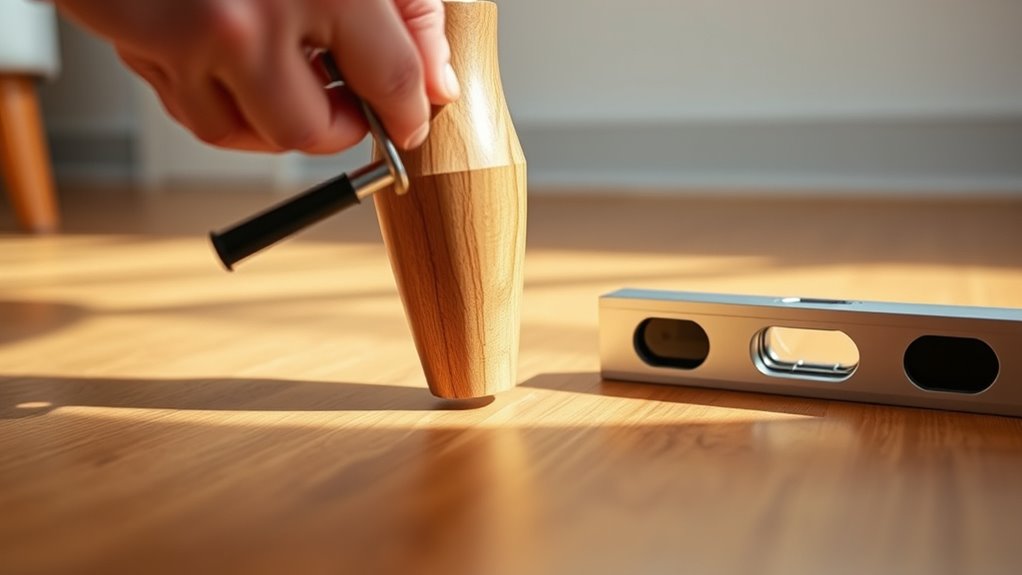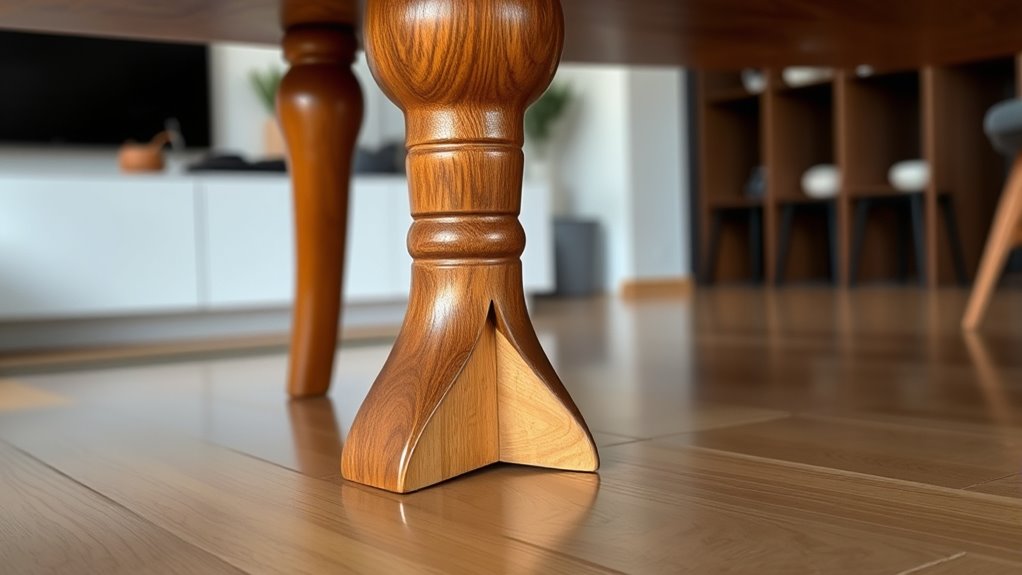To level uneven furniture legs, start by checking which legs are shorter or wobbly using a level tool. If your furniture has adjustable legs, turn the bolts clockwise to raise or counterclockwise to lower them until it sits evenly. For non-adjustable legs, place shims or pads under the shorter ones for quick stabilization. For a more permanent fix, consider installing adjustable levelers. Continue, and you’ll discover additional tips to keep your furniture stable and safe.
Key Takeaways
- Use a level tool to identify which furniture legs are uneven.
- Turn adjustable legs clockwise or counterclockwise to raise or lower them gradually.
- Apply furniture shims or pads under shorter legs for quick stabilization.
- Tighten all screws and bolts after making adjustments to ensure stability.
- Regularly check and re-level furniture to maintain evenness over time.

Have you ever noticed your furniture wobbling or uneven? It’s a common issue that can make your space feel unstable and uncomfortable. Luckily, fixing it isn’t complicated, and with a few simple steps, you can restore your furniture’s stability. The key lies in understanding how to perform proper leg adjustment, which is often the main cause of uneven furniture. When the legs aren’t level, the entire piece can tilt, causing wobbling and a feeling of imbalance. By addressing this, you’ll ensure your furniture stands firm and secure, making your space safer and more comfortable.
The first step is to identify which legs are uneven. Place a level tool on the top surface of the furniture—couches, tables, or chairs—to see where the imbalance is. Once you’ve pinpointed the uneven legs, it’s time to perform leg adjustment. Many furniture pieces come with adjustable legs, often with threaded bolts or screw-in feet that can be turned to raise or lower the height. If your furniture has these, simply turn the leg’s adjustment foot clockwise to raise it or counterclockwise to lower it. Do this gradually, checking the level frequently as you make adjustments. Your goal is to achieve a balanced position where the furniture sits evenly on all four legs, eliminating wobbling and improving overall stability.
If your furniture lacks adjustable legs, don’t worry—there are alternative solutions. You can use furniture shims or pads to level it. Place small pieces of cardboard, wood, or specialized furniture shims under the shorter legs until the furniture sits evenly. This method is quick and effective, especially for tables or cabinets. For more permanent solutions, you might consider attaching adjustable furniture levelers to the bottom of the legs. These levelers function similarly to threaded feet and allow for precise adjustments even after installation. Additionally, being aware that bad lemon juice can spoil quickly highlights the importance of proper storage and handling, which can extend the usability of perishable items like fruit juices.
Ensuring proper leg adjustment not only stabilizes your furniture but also prolongs its lifespan. When furniture wobbles, it experiences unnecessary stress and wear, which can lead to damage over time. Regularly checking and adjusting the legs keeps your furniture sturdy and safe, especially in households with children or pets. Remember to tighten any loose screws or bolts after making adjustments to prevent further wobbling. Taking a few moments to perform leg adjustment enhances your furniture’s stability, making your home a safer and more comfortable place to relax. With a bit of effort, you can keep your furniture steady and ensure it functions properly for years to come.
Frequently Asked Questions
Can I Use Household Items to Level Furniture?
Yes, you can use household items for quick fixes to level your furniture. Items like felt pads, coins, or small pieces of cardboard work well under uneven legs to stabilize them. Just place the chosen item under the shorter leg to raise it slightly, ensuring your furniture stays balanced. These household items are affordable and easy to use, making them perfect for quick fixes without needing specialized tools.
How Often Should I Check for Uneven Furniture?
A stitch in time saves nine, so you should check your furniture’s stability and leg maintenance every few months. Regular inspections help catch unevenness early, preventing further wobbling or damage. If you notice any instability, address it promptly to keep your furniture balanced. Don’t wait for a major issue—by staying proactive, you guarantee your furniture remains sturdy and safe, saving you time and effort in the long run.
Will Leveling Furniture Damage the Floor?
Leveling furniture usually won’t damage your floor if you use proper floor protection. Applying furniture pads or felt protectors under the legs helps prevent scratches and scuffs. When you adjust the legs for stability, you improve furniture stability and protect your flooring surfaces. Just make sure you’re gentle during adjustments and use appropriate padding to avoid any dents or marks, keeping both your furniture and floor in good condition.
What Tools Are Best for Adjusting Legs?
When it comes to adjusting uneven furniture legs, you’ll want to pick the right tools, as they’re your best bet for a smooth fix. A screwdriver with the appropriate type—Phillips or flat-head—is essential, depending on your furniture’s screws. Additionally, furniture foot pads can help stabilize legs and prevent slipping. Keep in mind, having the right tools makes the job easier, so don’t be afraid to invest in quality.
How Do I Prevent Furniture From Becoming Uneven Again?
To prevent furniture from becoming uneven again, focus on regular leg maintenance and ensuring furniture stability. Check and tighten screws or bolts periodically, especially after moving or heavy use. Use furniture pads or levelers to distribute weight evenly and absorb shocks. Keep furniture on a flat surface, avoiding moisture or uneven floors. These steps help maintain proper leg height, reducing the risk of future imbalance and prolonging the stability of your furniture.
Conclusion
Now that you know how to level uneven furniture legs, you can tackle wobbling tables and chairs with confidence. Think of it like fixing a wobbly ladder—once you tighten the legs, everything stands steady and secure. With a few simple tools and some patience, you’ll have your furniture sitting perfectly balanced in no time. So go ahead, give it a try, and enjoy a more stable, comfortable space that’s as solid as a rock!









